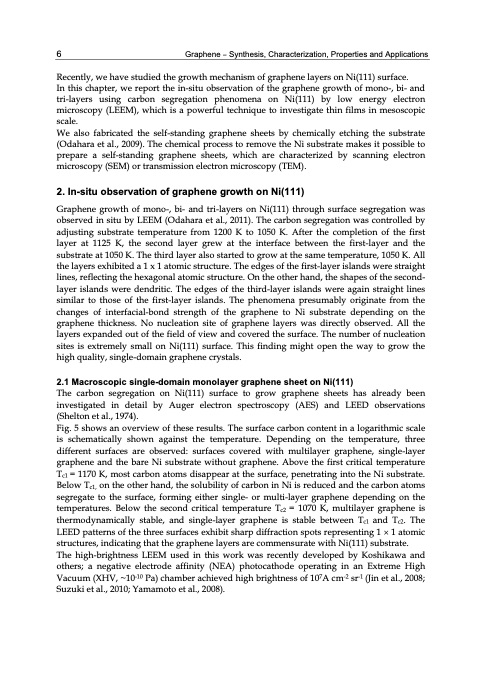PDF Publication Title:
Text from PDF Page: 016
6 Graphene – Synthesis, Characterization, Properties and Applications Recently, we have studied the growth mechanism of graphene layers on Ni(111) surface. In this chapter, we report the in-situ observation of the graphene growth of mono-, bi- and tri-layers using carbon segregation phenomena on Ni(111) by low energy electron microscopy (LEEM), which is a powerful technique to investigate thin films in mesoscopic scale. We also fabricated the self-standing graphene sheets by chemically etching the substrate (Odahara et al., 2009). The chemical process to remove the Ni substrate makes it possible to prepare a self-standing graphene sheets, which are characterized by scanning electron microscopy (SEM) or transmission electron microscopy (TEM). 2. In-situ observation of graphene growth on Ni(111) Graphene growth of mono-, bi- and tri-layers on Ni(111) through surface segregation was observed in situ by LEEM (Odahara et al., 2011). The carbon segregation was controlled by adjusting substrate temperature from 1200 K to 1050 K. After the completion of the first layer at 1125 K, the second layer grew at the interface between the first-layer and the substrate at 1050 K. The third layer also started to grow at the same temperature, 1050 K. All the layers exhibited a 1 x 1 atomic structure. The edges of the first-layer islands were straight lines, reflecting the hexagonal atomic structure. On the other hand, the shapes of the second- layer islands were dendritic. The edges of the third-layer islands were again straight lines similar to those of the first-layer islands. The phenomena presumably originate from the changes of interfacial-bond strength of the graphene to Ni substrate depending on the graphene thickness. No nucleation site of graphene layers was directly observed. All the layers expanded out of the field of view and covered the surface. The number of nucleation sites is extremely small on Ni(111) surface. This finding might open the way to grow the high quality, single-domain graphene crystals. 2.1 Macroscopic single-domain monolayer graphene sheet on Ni(111) The carbon segregation on Ni(111) surface to grow graphene sheets has already been investigated in detail by Auger electron spectroscopy (AES) and LEED observations (Shelton et al., 1974). Fig. 5 shows an overview of these results. The surface carbon content in a logarithmic scale is schematically shown against the temperature. Depending on the temperature, three different surfaces are observed: surfaces covered with multilayer graphene, single-layer graphene and the bare Ni substrate without graphene. Above the first critical temperature Tc1 = 1170 K, most carbon atoms disappear at the surface, penetrating into the Ni substrate. Below Tc1, on the other hand, the solubility of carbon in Ni is reduced and the carbon atoms segregate to the surface, forming either single- or multi-layer graphene depending on the temperatures. Below the second critical temperature Tc2 = 1070 K, multilayer graphene is thermodynamically stable, and single-layer graphene is stable between Tc1 and Tc2. The LEED patterns of the three surfaces exhibit sharp diffraction spots representing 1 1 atomic structures, indicating that the graphene layers are commensurate with Ni(111) substrate. The high-brightness LEEM used in this work was recently developed by Koshikawa and others; a negative electrode affinity (NEA) photocathode operating in an Extreme High Vacuum (XHV, ~10-10 Pa) chamber achieved high brightness of 107A cm-2 sr-1 (Jin et al., 2008; Suzuki et al., 2010; Yamamoto et al., 2008).PDF Image | GRAPHENE SYNTHESIS CHARACTERIZATION PROPERTIES

PDF Search Title:
GRAPHENE SYNTHESIS CHARACTERIZATION PROPERTIESOriginal File Name Searched:
Graphene-Synthesis.pdfDIY PDF Search: Google It | Yahoo | Bing
Salgenx Redox Flow Battery Technology: Power up your energy storage game with Salgenx Salt Water Battery. With its advanced technology, the flow battery provides reliable, scalable, and sustainable energy storage for utility-scale projects. Upgrade to a Salgenx flow battery today and take control of your energy future.
CONTACT TEL: 608-238-6001 Email: greg@infinityturbine.com (Standard Web Page)